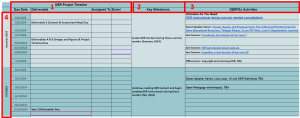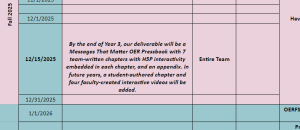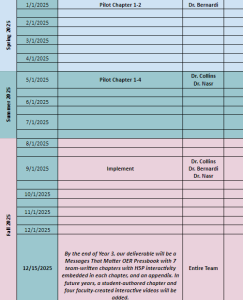Creating Your Project Timeline
3.1 Creating Your Project Timeline
Theresa Huff
Creating Your Project Timeline
Learning Objectives
- Create a working Project Timeline with deadlines, deliverables, and assigned tasks to the end of the grant (December 15, 2025).
Congratulations! You’ve designed your entire OER from learning objectives to your Table of Contents to your Content and Assessments, and even some of your Images and Figures. In the process of designing, you’ve likely had some rich and important conversation with your team and others. You now have the major parts of the plan and all the pieces you need to begin development of your OER. The last step before starting to develop your OER is to make a plan for:
- Which OER pieces will be developed?
- Who will develop the different pieces of the OER?
- When will each piece be completed?
- Who will manage the final pieces of preparing the OER for implementation?
- Who, when, and where will your OER be implemented?
Creating a project timeline will help you answer each of these questions, break the larger work of creating your OER into manageable, bite-size chunks, and remove uncertainty about your project. It also serves as a point of communication with your team. This chapter will take you and your team step-by-step through creating a project timeline.
This set of directions are to be used alongside the OER Project Timeline tab of the OERFSJ Deliverables 1-5 spreadsheet.
Step 1 – Orient Yourself to the OER Project Timeline Template
Watch a brief overview of this step.
Your Turn – Explore Deliverable 5
Deliverable 5 is the OER Project Timeline where you will map out the development and implementation of your OER from now until the end of Year 3.

The OER Project Timeline includes four columns for this purpose: Due Date, Deliverable, Assigned To, and Done [1].
- Due Dates may be added as needed by adding rows to your spreadsheet.
- Deliverables are the completed pieces of the OER you plan to complete by the Due Date.
- Assigned To are the team members responsible for completing the Deliverables by the Due Date.
- Done! is where team members communicate that the work for which they are responsible is completed. This can also be used to add notes to communicate with other team members.
The OER Project Timeline also includes Key Milestones [2] to aid your planning as well as OERFSJ Activities (scheduled events and events yet to be scheduled) [3] to guide your timeline creation.
The OER Project Timeline is visually divided into seasonal terms from now until the end of the grant [4].
Step 2 – Identify the Year 3 OER Deliverable, Implementation, and Pilot Dates
Watch a brief overview of this step.
Your Turn – Schedule Your Deliverable and Implementation
Just as we did with mapping your formative assessments, we start planning our project timeline with the end in mind.
Year 3 OER Deliverable
1. As a team, finish this sentence:
“By the end of Year 3, our OER Deliverable will be….”
The answer to this statement becomes the final task of your Year 3 OER Deliverable.
2. In the Due Date column, find 12/15/2025. In the Deliverable column next to this due date, enter your OER Deliverable statement. Be as specific as possible, adding what you will and won’t have complete by the end of Year 3 (December 15, 2025).
Example:
“By the end of Year 3, our deliverable will be a Messages That Matter OER Pressbook with 7 team-written chapters with H5P interactivity embedded in each chapter, and an appendix. In future years, a student-authored chapter and four faculty-created interactive videos will be added.”
3. Now, assign it to the whole team in the Assigned To column.

Pilot and Implementation
Before you publish and promote your OER Deliverable at the end of Year 3, you will want to implement it into your course. This allows you to test it, get feedback from your students, and make revisions before you publish to an institutional repository for others to use. According to the grant specifications, you are expected to implement and teach with your new OER in Year 3 of the grant. However, we strongly encourage piloting your OER or parts of your OER as much as possible before implementation. This will ensure we have solid outcomes to report to the Department of Education.
- As a team, find the Spring 2025 and Fall 2025 areas of Project Timeline. These are the terms we expect you to implement and teach with your OER. In the Deliverable column, state when you will Implement your OER.
- Notice that Spring 2025 is the recommended time to Pilot your OER, allowing Summer 2025 as time for revisions. However, you may pilot as early as Summer 2024. For example, you might pilot one chapter or section of your OER to gauge student learning before piloting the entire OER in the following term. In the Deliverable column, state when you will Pilot your OER.
- In the Assigned To column, state who will piloting and implementing the OER during which terms.

Now that you have clarified and scheduled the published OER Deliverable and when you plan to pilot and implement it, as a team, you will plan the pieces that will lead to those deadlines. Use the OER Project Timeline to map out what will be done (Deliverables), when each will be done (Due Date), and who will be responsible for each Deliverable’s completion (Assigned To).
Note: Though not required, we recommend that each individual member also create a project timeline for their own assigned tasks as well. A Sample Individual Project Timeline tab is included in the spreadsheet for duplication for each team member.
Step 3 – Schedule the Content Development
Watch a brief overview of this step.
Your Turn – Schedule Your Content Development
- As a team, review the Assigned To column on your Table of Contents.
- Team Lead: In the OER Content and Assessment Map, guide your team from Chapter 1 to the end of the Table of Contents, identifying the person assigned the chapter or chapter section and addressing only the content. Inquire how long the team member predicts they will need to accomplish their To Do lists.
- Team Members: Use the OER Content Map section from the OER Content and Assessment Map tab to name the content deliverables for each chapter or chapter section and estimate how long they will need to complete its creation or adaption.
What might this look like?
Team Lead: “Chapter 1, Section 1 is assigned to James. James, what is your plan for Chapter 1, Section 1?”
James, consulting his To Do List for Chapter 1, Section 1: “I’ve already gotten about half of this section written, but I plan to write about another 2 pages, and I need to make a 5-minute video.”
Team Lead: “Ok, when do you think you will have the writing complete?
James: “Probably by the middle of July.”
In the Due Date column at the middle of July the Team Lead places the due date of “July 15”; in the Deliverable column, “Chapter 1, Section 1 writing”; and in the Assigned To column “James”.
Team Lead: “And how about the video creation?”
James: “I should have all of my videos done by end of July”.
In the Due Date column at the end of July, the Team Lead places the due date of “July 31”, in the Deliverable column “Chapter 1, Section 1 video”, and in the Assigned To column, “James”.

The Team Lead continues this process through each chapter and section until all content deliverables are on the timeline.
Step 4: Schedule the Formative Assessments Development
Watch a brief overview of this step.
While your Summative Assessments are likely going to be held in your course, the Formative Assessments may be placed in your course or your OER. In this section, you will be scheduling and assigning creation of formative assessments you wish to build and place in your OER.
Generally, but not always, the content portions of the OER are at least drafted before formative assessments are developed. Depending on the project, the creation of these may be assigned to one or two team members or divided up between all the team members. Regardless, time for training and development of these pieces must be added to the project timeline to ensure they are created and integrated into the OER in a timely manner.
Your Turn – Schedule Your Formative Assessment Development
As a team, review the OER Assessment Map section from the OER Content and Assessment Map tab. Discuss the following questions:
- Which formative assessments will be created for the Year 3 OER Deliverable?
- Which formative assessments will be created in the future (beyond the grant)?
- Which formative assessments could be combined?
- Which formative assessments already exist but need adapting?
- Is each team member creating their own formative assessments or will one or more team members create all of the formative assessments?
- If each team member in the Assigned To column of the Table of Contents will be creating their own formative assessments for their assigned section or chapter, follow the same process you did for scheduling the content development to identify what formative assessments need to be created, who will create it, when it will be delivered, and place that information on the OER Project Timeline.
- If one or more team members will be taking on creation of a group of formative assessments or interactivity, be sure to name all members responsible for each creation in the Assigned To column of the OER Project Timeline.
Note: If you plan to include Summative Assessments in your OER, schedule their development now, following the steps above.
Step 5: Schedule OER Image and Figures
Watch a brief overview of this step.
Your Turn: Schedule Your Images and Figures
Throughout the design process, everyone has likely been adding images and figures they think they might use to the OER Images and Figures tab. However, your team will need to decide:
- Who will make the final choice of images and figures to be used?
- Who will ensure they are licensed correctly?
- Who will ensure images include alt text and captions?
- Who will ensure they are cohesively placed throughout the OER?
- After reviewing the OER Images and Figures tab, identify who will be responsible for each of the above items.
- Each responsible team member should estimate when they will have each of the above responsibilities complete. Notice that the OERFSJ Review for Copyright, Accessibility, and DEIA Checks by the OERFSJ Grant Team is scheduled for July 1, 2025. Therefore, you will want to ensure your initial review is complete before then. They should then place the estimated completion date in the Due Date column, state their responsibility in the Deliverables column, and add their name in the Assigned To column.
Step 6: Schedule OER Final Pieces
Watch a brief overview of this step.
The final pieces of your OER will include formatting the OER, reviewing the content, and editing. While your OER Librarian and OER Instructional Designer can support your team in these endeavors, these tasks will need to be assigned and scheduled as deliverables to ensure they are completed by your Year 3 OER Deliverable due date.
Identify the team member(s) responsible for each of the following pieces of your OER and add that deliverable to your OER Project Timeline.
Your Turn: Scheduling Your OER Formatting
Your OER will likely have some formatting components that will require your team’s time and attention. This could include:
- front matter
- back matter
- acknowledgements
- appendix
- style guide
- As a team, discuss what will be included in the front matter, back matter, acknowledgments, appendices, and adherence to style guide.
- Identify who will be responsible for this work.
- Each responsible team member should estimate when they will have each of the above responsibilities complete.
- They should then place the estimate completion date in the Due Date column, state their responsibility in the Deliverables column, and add their name in the Assigned To column.
Your Turn: Schedule Your Content Review
The responsibility of the initial review of your entire OER belongs to your team. Notice that the OERFSJ Review for Copyright, Accessibility, and DEIA Checks by the OERFSJ Grant Team is scheduled for July 1, 2025. Therefore, you will want to ensure your initial review is complete before then.
- Set three Deliverables with three Due Dates on your OER Project Timeline for this review:
- Start content review.
- Meet to finalize changes needed.
- Review complete.
- In the Assigned To column, include the entire team.
Once complete, your OER will be ready to be submitted to the OERFSJ team for editing and internal review.
The responsibility of the editing and internal review belongs jointly to your team and OERFSJ grant administration team. Now that your team has reviewed the OER, you will need to submit it to the OERFSJ grant administration team for review by July 1, 2025.
You may want to take advantage of a Peer Review of your OER. While this is optional, ideally you would want to allow a Peer Review to coincide with your Implementation. Notice that an OER Peer Review is recommended for Summer 2025 or Fall 2025.
The OERFSJ grant administration team will be conducting a grant assessment of all OER and the overall grant project beginning January 1, 2026.
Your Turn: Schedule Team Check-ins
Once you begin the development of your OER this summer, your team will be largely working autonomously, reaching out for help or support from your liaison, OER Instructional Designer, and OER Librarian as needed, and attending scheduled jam sessions and workshops. Your team will need to meet regularly to
- answer questions that arise.
- attend training sessions or workshops.
- help keep one another accountable and encouraged.
- adjust the OER Project Timeline.
- As a team, schedule and add to your OER Project Timeline:
- Regular team check-ins in which your team can give updates on your progress and track and celebrate completion of deliverables with one another. As tasks are completed, responsible members can check them off in the Done column.
- Meeting dates and any other get-togethers with your team and the OERFSJ team.
- Ensure each entry includes:
- The planned date of the meeting or workshop in the Due Date column.
- The purpose of the meeting or workshop in the Deliverables column.
- A list of those attending in the Assigned To column.
Congratulations! You have now created a roadmap for you and your team to develop your OER. Each member of your team should know what to do and by when. Individual members can keep track of their own tasks in their own OER Project Timeline, if they choose, using the Sample Individual Project Timeline tab. Remember that you have a support team as questions arise, training is needed, or motivation wanes. We are cheering for you and here to help!
Deliverable 5
Deliverable 5 is the completed OER Project Timeline.
Once complete, you are ready to email OERFSJ@lmu.edu to let them know your Deliverable 5 is complete. Note: Remember that Deliverable 4 (OER Images and Figures) is also due at this time.
